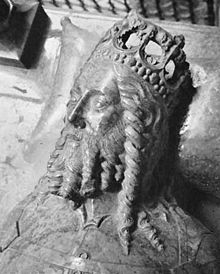
Back كازيمير الثالث الأعظم Arabic III Kazimir Azerbaijani اۆچونجو کازیمیر AZB Казімір III Вялікі Byelorussian Казімер III Вялікі BE-X-OLD Кажимеж III Велики Bulgarian Kazimir III, kralj Poljske BS Casimir III Catalan Kazimír III. Veliký Czech Kadzmiérz Wiôldżi CSB
| Casimir III the Great | |
|---|---|
 Casimir's tomb effigy in Wawel | |
| King of Poland | |
| Reign | 1333–1370 |
| Coronation | 25 April 1333 |
| Predecessor | Ladislaus the Short |
| Successor | Louis I of Hungary |
| King of Ruthenia | |
| Reign | 1340–1370 |
| Predecessor | Yuri II of Galicia |
| Successor | Louis I of Hungary |
| Born | 30 April 1310 Kowal, Duchy of Brześć Kujawski |
| Died | 5 November 1370 (aged 60) Kraków, Poland |
| Burial | Wawel Cathedral, Kraków |
| Spouse | Aldona of Lithuania Adelaide of Hesse Christina Rokiczana (morganatic) Hedwig of Sagan |
| Issue more... | Elisabeth, Duchess of Pomerania Anna, Countess of Cilli |
| House | Piast |
| Father | Władysław I Łokietek |
| Mother | Jadwiga of Kalisz |
| Signature |  |
Casimir III the Great (Polish: Kazimierz III Wielki; 30 April 1310 – 5 November 1370) reigned as the King of Poland from 1333 to 1370. He also later became King of Ruthenia in 1340, and fought to retain the title in the Galicia-Volhynia Wars. He was the last Polish king from the Piast dynasty.
Casimir inherited a kingdom weakened by war and under his rule it became relatively prosperous and wealthy. He reformed the Polish army and doubled the size of the kingdom. He reformed the judicial system and introduced several undying codified statutes, gaining the title "the Polish Justinian".[1] Casimir built extensively and founded the Jagiellonian University (back then simply called the University of Krakow),[2] the oldest Polish university and one of the oldest in the world. He also confirmed privileges and protections previously granted to Jews and encouraged them to settle in Poland in great numbers.[3]
Casimir left no legitimate sons. When he died in 1370 from an injury received while hunting, his nephew, King Louis I of Hungary, succeeded him as king of Poland in personal union with Hungary.
- ^ Saxton, L. C. (1851). Fall of Poland; containing an analytical and a philosophical account of the causes which conspired in the ruin of that nation; together with a history of the country from its origin, in two volumes. Vol. I. New York: Charles Scribner publishing company. pp. 89.
- ^ Saxton, 1851, p. 535
- ^ Aharoni, Yohanan (2006-09-15). The Jewish People: An Illustrated History. A&C Black. p. 220. ISBN 978-0-8264-1886-9.